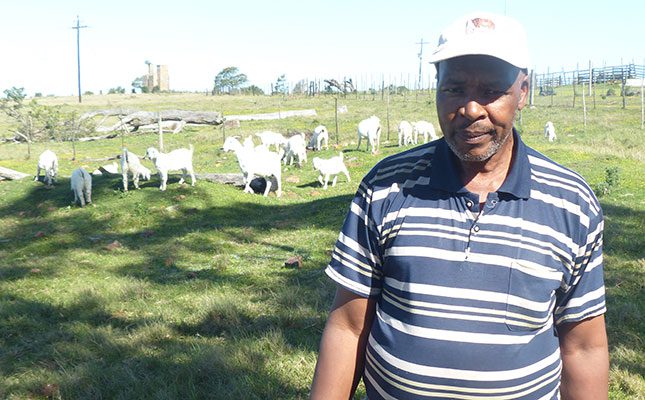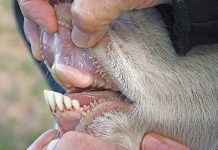
Photo: Mike Burgess
Desmond Siteti’s herd of almost 80 Bonsmara breeding females run side by side with a small flock of Savanna goats (35 mature ewes) that capitalise on the browsing potential of the 500ha mixed-veld farm, Tower Hill, near Makhanda, while also generating crucial cashflow.
‘’It is a good balance to have goats on the farm with my cattle,’’ says Siteti, aged 69.
“They browse a lot, manage bush encroachment, and reach parts of the farm the cattle can’t while providing a valuable source of cashflow to handle expenses including lick supplements that have gone up, like petrol.’’
Getting going with goats
Siteti grew up on a commercial farm in the Makhanda district, where his father, Thompson, tended to a flock of goats, a job Siteti was more than willing to help with after school.
In the 1970s, the Siteti family relocated to nearby Pikoli in the then Ciskei where Siteti and his brother, Metford, managed a flock of Mbuzi-type goats and some cattle on communal land.
However, by the late 1970s Siteti left Pikoli for the mines of the Witwatersrand (before his departure he committed to travelling back home as often as he could), while Metford continued to manage the livestock in Pikoli.
Capital
Siteti spent almost four decades on the Witwatersrand, mainly in the processing division of the Gold One Group, and contributed significant amounts of capital to the Pikoli-based livestock initiative.
As early as 1982, for example, Boer goat rams were purchased for the Mbuzi-type ewes. The brothers were deeply impressed by the conformation of the crossbred offspring and Siteti still runs a flock of 60 Boer goat-type ewes in Pikoli.
In 1995, Siteti visited a commercial farmer across the Great Fish River to buy sheep (for slaughter) for his mother’s funeral and it was here that he first saw a herd of all-white Savanna.
Not long after this he returned to this farm and bought 10 Savanna ewes and a ram that were incorporated into his Pikoli Boer goat-type flock.
In 2004, Metford passed away, and a host of family members/managers were employed over the years with varying success to manage the Pikoli livestock initiative.
In 2012 Siteti acquired Tower Hill, about 20km from Pikoli, through the state land reform programme. All Pikoli-based cattle were promptly moved to this new farm and put to Bonsmara bulls while 40 Savanna ewes and a ram were purchased for the farm from local breeder John Dell.
Poor fencing
However, Tower Hill had poor fencing and Siteti would often receive calls from neighbours about his Savanna goats on the nearby N2 highway or in their veld.
“I therefore decided to sell all my Savanna, by then numbering 90 ewes, as I realised I might lose them anyway,’’ he says. “I then settled on Boer goats in Pikoli and Bonsmara cattle on Tower Hill.”
However, when Siteti returned permanently to the Eastern Cape in 2016 he began once again toying with the idea of Savanna goats and in 2020 eventually sourced 35 young Savanna ewes and a ram via the Eastern Cape Department of Rural Development and Agrarian Reform’s stock improvement scheme.
These goats were again purchased from the Dell family, and today Tower Hill is again home to white goats.
Siteti is once again addressing the fencing challenge on Tower Hill with the entire eastern boundary fence having been made goat-proof – the final goal is enclosing the entire farm.
Savanna rams run with the ewes throughout the year and Siteti says one ram is sufficient for up to 50 ewes. The fertility of Siteti’s Savanna is also reflected by a kidding rate of 140%, with twins, triplets and even quadruplets not being uncommon.

Young ewes conceive before 12 months of age (a replacement rate of about 15% is adhered to) while ewes kid throughout the year.
Kids are traditionally weaned at six months but currently Siteti prefers to wean them at four months to allow ewes some extra rest before their next cycle.
Although the South African-bred Savanna is an extremely hardy goat, the flock on Tower Hill is regularly treated for ticks to prevent specifically redwater and heartwater.
Home of the tick
Besides being dipped twice a month in summer and once a month in winter, they are also blocked every three months. This is especially the case for weaned Savanna that are transferred to Pikoli to ensure complete separation from their mothers, where tick loads are particularly heavy.
“There along the Fish River, is the home of the tick,’’ says Siteti. The continuous need for dipping has also ensured that ticks have become resistant to certain products, necessitating the use of different products over time to ensure efficacy.
Internal parasites are as great a challenge as external parasites and the dosing of all goats every three months is the norm; the same resistance issues to products apply to internal parasites, says Seteti.
The goats also receive a standard immunisation programme and although they are technically not given any lick supplements, Siteti says they help themselves to the cattle’s protein and phosphate licks.
Also, each goat receives a cup of maize when returning to the veld each morning – all goats are kraaled at night to protect them from predators.
Savanna goats are sought-after in the traditional livestock markets of the Eastern Cape, says Siteti.
“We [the Xhosa] believe that with white goats one will be truly blessed and they are therefore preferred as a slaughter animal to be used in traditional rituals. A white goat is number one when it comes to rituals.’’
Siteti believes in breeding only top-quality animals with good conformation for the market.
“I believe in breeding quality goats with good conformation, that sell themselves,’’ explains Siteti. “A buyer must not hesitate.’’
Siteti’s knowledge of goat prices fetched at local auctions helps him understand trends in the formal market; a valuable tool, he emphasises, in determining a price in the informal market.
Top prices
In the last year, Siteti’s six-month-old kapaters (25kg-30kg) and four-month-old kapaters (20kg-25kg) fetched top prices of R2 500 and R2 000, respectively.
“You don’t want to charge people too much and also not too little. You therefore always have to be checking on goat prices in the region,” he says.
Then there is the sale of Savanna breeding stock in the form of young ewes and rams to especially communal farmers who seem determined to transform their flocks of multi-coloured crossbred goats to white goats.
“There is a huge demand for Savanna breeding stock,’’ says Siteti. “They [ communal farmers] want to change their goats to pure white animals.’’
Young Savanna rams are sold at the same age as kapaters (15 in the last year) while all young Savanna ewes, if not selected as replacements in Siteti’s breeding flock, are sold as breeding stock.
Siteti has few regrets but one he has is he cannot run more Savanna on Tower Hill.
“If I had more land, I would have 100 top Savanna ewes, but I know I can’t have more than 60 on the farm. Savanna goats just turn money over quickly,” he says.
Phone Desmond Siteti on 083 418 5558.













